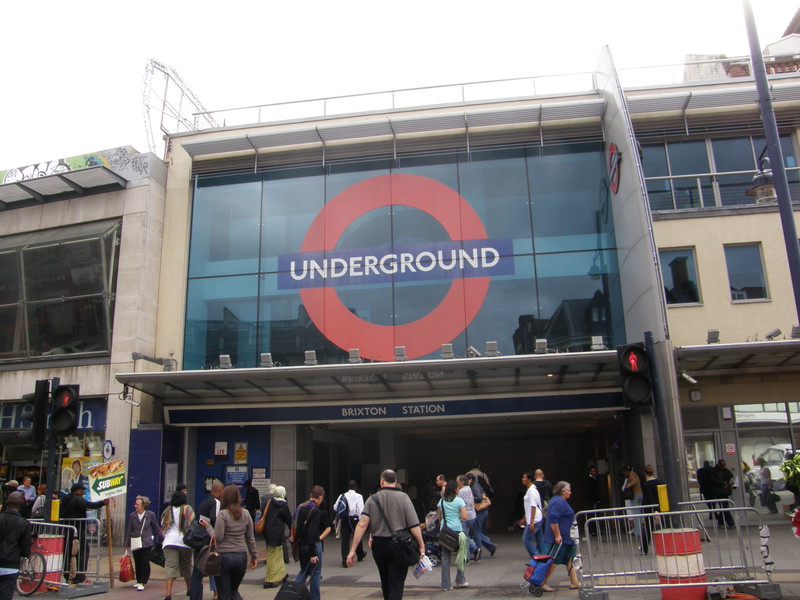
It's a bit like walking on eggshells round here at the moment. Every night I check out the weather forecast, wondering whether I'm going to get a soaking on tomorrow's walk, and every night the forecast is for scattered showers, sometimes heavy, sometimes not. And so I get up in the morning and frown out of the window, angry at yet more pathetic August weather and expecting the worst.
But does it rain? Well, no, not really. Yesterday's forecast was for scattered heavy showers, and it rained for precisely five minutes, most of which I spent cowering inside the nice warm ticket hall at Park Royal. Today's forecast was for scattered showers, particularly in the afternoon, but it didn't rain once, and the afternoon turned out to be, well, sunny. I guess this is the kind of weather that you just can't predict, and they might be erring on the side of caution given the recent floods in Northern Ireland, but I think I might give up watching the forecast and head out in blissful ignorance; that way I might even come out the other end of this thinking that we had quite a good summer, rather than the dismal apocalypse we seem to be having in the world of TV news.
Brixton to Stockwell
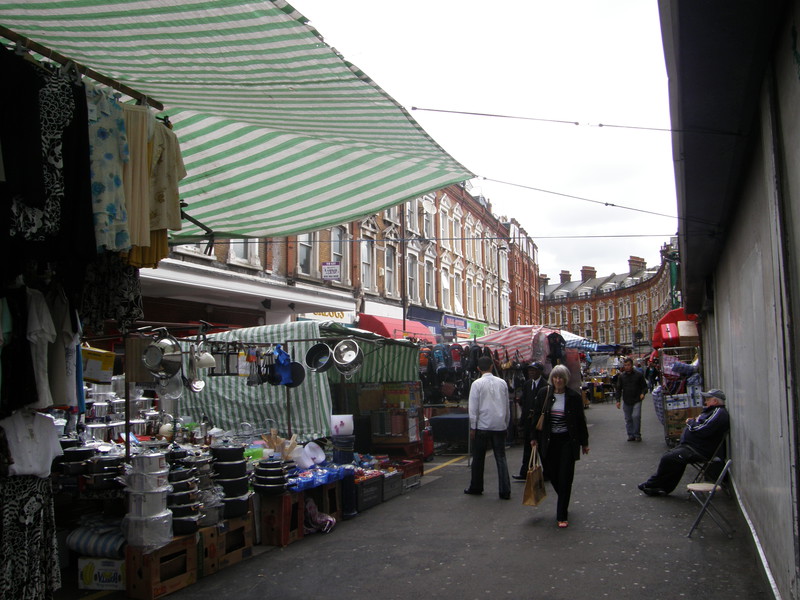
Brixton has an image problem, which is perhaps not surprising as there were serious race riots in 1981, 1985 and 1995, and the images stay in the collective consciousness for a long time... but it's been 13 years since the last riot, and things look pretty buoyant, at least to the casual observer. Brixton station has an impressive new entrance, boasting a huge glass Underground roundel above a large steel staircase, and at the top of the stairs you burst out into Brixton Road, one of the liveliest high streets I've seen for a while. The last time I was here I remember watching a naked woman running down the street, completely out of her mind, while concerned members of the public tried to calm her down and stop her playing with the traffic; I didn't see anything quite as bizarre today, but Brixton is the kind of place where you feel something is about to happen, and it's very invigorating.
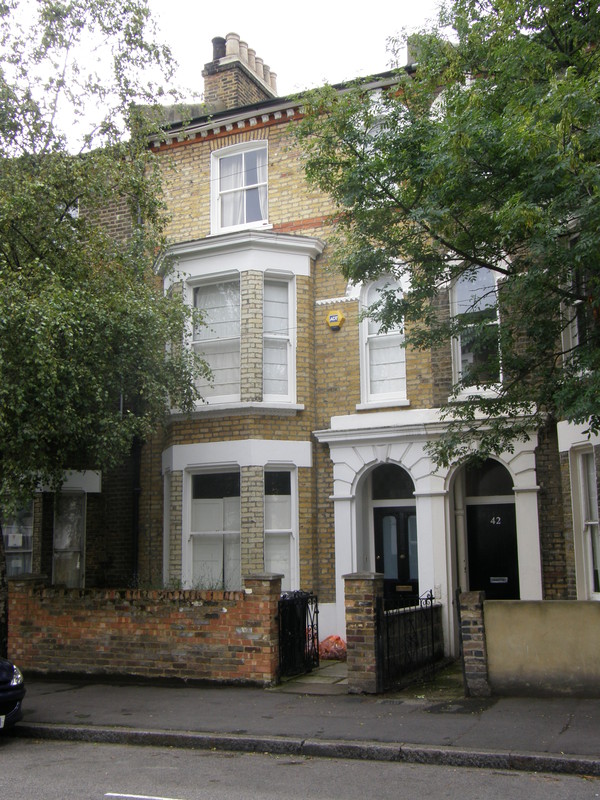
Just round the corner from the Tube station is Electric Avenue, where the colourful Brixton Market stretches all the way round the back of the station, throbbing to the sound of reggae and lively conversation. Electric Avenue got its name by being the first shopping street in London to have electric street lighting, way back in 1888, though the Victorian iron and glass canopies that covered the pavements were removed in the 1980s; it was also the inspiration for Eddy Grant's 1983 number two hit of the same name, the one that's currently on rotation as the soundtrack to a Currys advert, though they mercifully weren't playing that as I wandered through.
Heading up Brixton Road, past the Brixton Academy – currently hosting the inimitable Kings of Leon – and up the Stockwell Road, you notice quite a bit of interesting architecture. Brixton is a real mixture of solid Victorian and Edwardian terracing and more modern (and far less attractive) social housing, and the side streets can be quite delightful. One typical example of a terraced Brixton road is Stansfield Road, where David Bowie was born and spent his first six years in the unassuming house at number 40. One day it will no doubt get a blue plaque, but Bowie is still alive, so it will just have to wait.

Turning right down Sidney Road takes you into Stockwell Park Conservation Area, which I first went through on my Northern line walk from Euston to Kennington, and it's just as beautiful second time round. The houses along Stockwell Park Crescent are particularly attractive, with neo-Georgian terraces and stucco houses hiding behind lush trees. Hemmed in on all sides by rather less attractive housing estates, this is an oasis of old London among the new, and it's easy to see why it's been made a conservation area; coming out into Stockwell Road opposite the depressingly 20th-century Stockwell Garden Estate only makes the point clearer.
Stockwell station is just up the Stockwell Road, and I'm afraid it isn't a particularly attractive piece of architecture. It's also hard to look at it without thinking of the police shooting of poor old Jean Charles de Menezes back in 2005; it's going to take a while for that particular association to fade away, and the fact that there was a man filming a piece to camera in Portuguese outside the station shows that this story isn't going away any day soon.
Stockwell to Vauxhall
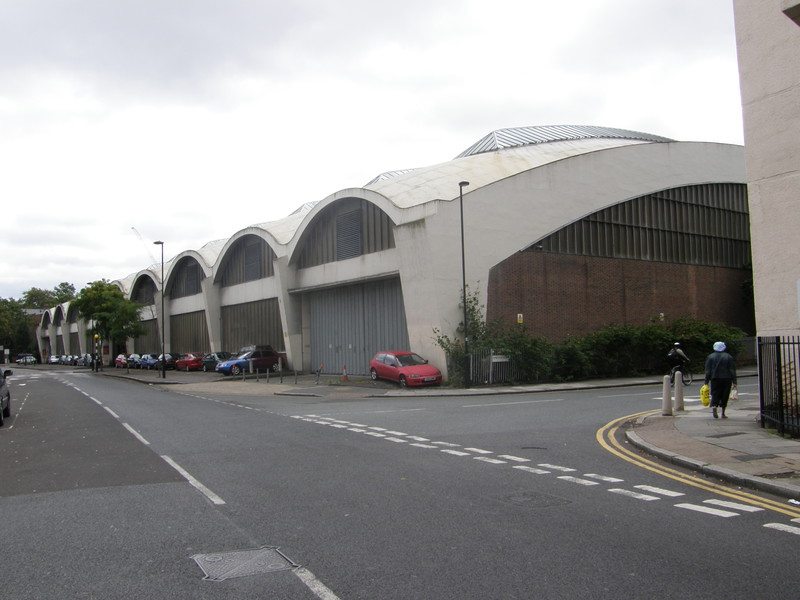
Past the station, the Studley Estate dominates the view along Binfield Road, with a high rise block in front of you and sturdy blocks either side of the road, but keep on going to the bend in the road and you get your first glimpse of the Grade II*-listed Stockwell Garage. When it opened in 1952, the graceful concrete and steel arches of Stockwell Garage created the largest unsupported area under one roof in Europe, and it could house 200 buses; it's still in use as a bus depot today, and when you reach Lansdowne Way, look to your right to get an idea of just how immense the structure really is.
Lansdowne Gardens is just off the main road, and it's another hidden gem. The circus in the middle of the block is surrounded by lovely terraced houses, and out on Guildford Road a large church dominates the skyline. On the corner of Guildford Road and St Barnabas Villas, opposite the church, was a mass of floral tributes to a young black guy, though I couldn't work out what his name was or what had happened to him (though, in the current climate, the chances are he was the victim of a knife attack). There's another modern estate on the corner here, though I don't know if that had anything to do with it.
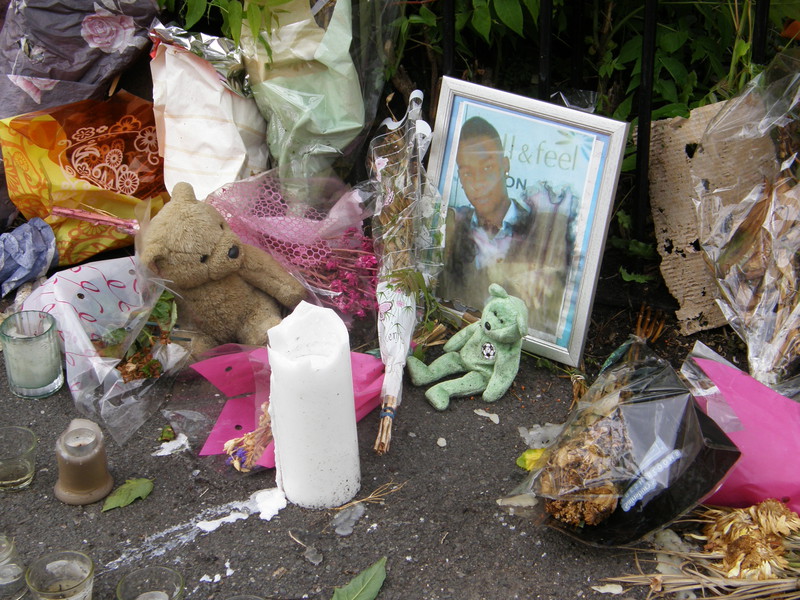
On the other side of the South Lambeth Road (which is known as Little Portugal at this point, due to the large number of Portuguese who moved here during the 1960s and 1970s to flee the dictatorship in their home country), the housing again slips into Victorian excellence, passing the extremely modern St Stephen's Church before morphing into the huge mansion blocks of yet another estate. The amount of social housing in this part of the capital is truly impressive, as is the range of designs; some are old, with huge brick chimneys and a distinctly Edwardian air, and some are modern, with a depressing sense of the 1960s and 1970s about them. It's an interesting exercise to compare them, though to me there's only ever one winner, at least on the aesthetic front.

Vauxhall Park is on the other side of Fentiman Road, with the entrance to the right of the junction with Rita Road, though when you enter you might be forgiven for thinking that the park is out of bounds to mere humans. The attractive lavender beds and formal garden are locked away behind steel fences, but there are gates to be found, and it turns out that the fences are there to keep dogs out, not people. The lavender is heavenly at this time of year, and there's an intriguing set of miniature houses at the far end, just as the park opens out into a more traditional green space.
Vauxhall station is on the other side of the train tracks, through a spooky underpass. The original railway station is on the right as you come under the bridge, but straight ahead there's an impressive new bus station and Tube entrance that's shaped like a huge steel sea serpent, with massive steel tusks pointing into the air above the junction with Vauxhall Bridge Road. The Tube station is hidden underground, perhaps sensibly, given the amount of traffic hurtling over Vauxhall Bridge.
Vauxhall to Pimlico
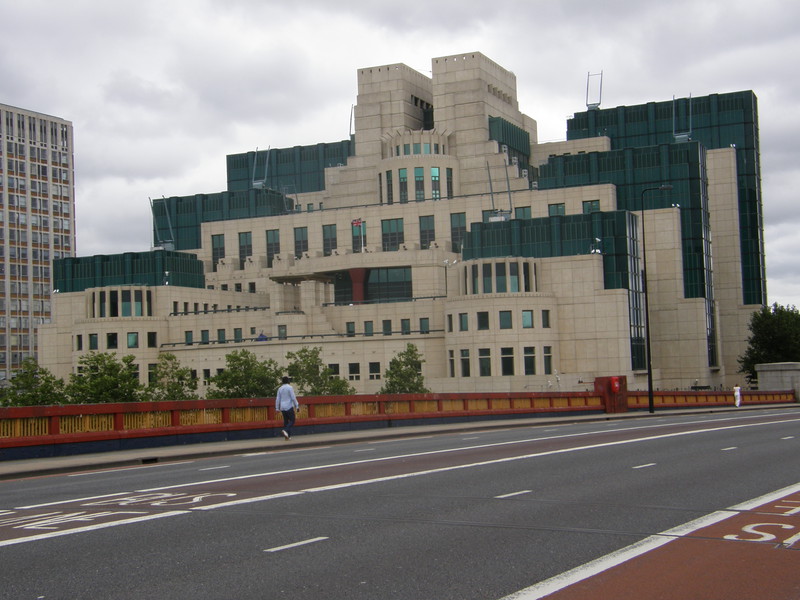
This whole area is dominated by two huge developments. On the southwest side of the bridge is St George's Wharf, a massive apartment development whose peaked towers look like confused cockroaches, or perhaps a row of startled WALL-Es. Much more impressive is the SIS Building on the northeast side, the home to the security service MI6. It really looks like the headquarters of a spy agency; it means business, and it's no surprise that when the Provisional IRA fired a mortar at the building in 2000, it effectively bounced off, causing only minor damage.
I nearly got blown off Vauxhall Bridge and had to hurry across, though as the tide was out, the view across to Battersea Power Station wasn't at its best. It was a relief to get to the shelter of Grosvenor Road, where modern blocks rub shoulders with old pubs and stranded period homes. The Peabody Trust's Tachbrook Estate dominates the north side of the road, and it's an attractive companion as you walk along Aylesford Street towards Pimlico.
Pimlico station is hidden below ground, with an anonymous entrance in the base of an office block. Interestingly, Pimlico is the only station on the whole Victoria line that doesn't have an interchange with either a Tube line or a national railway line, and it was also a last-minute addition to the line, opening in 1972, more than a year after the rest of the line had opened.
Pimlico to Victoria

The architecture along Tachbrook Street is a face-off between the old and the new. On the western side of the road is a row of Victorian terraces of the kind you can see pretty much anywhere in London, but on the eastern side of the road is the mid-1960s Lillington Gardens Estate, which is an absolute corker. Layers of red brick balconies cascade down towards the road, ending in pubs and shops and ground floor flats with pretty gardens, and the difference between this fluid design and your average tower block is huge. The inhabitants of the 780-odd apartments in the estate are keen on window boxes, and the result is not unlike a red-brick version of the Barbican; it was deservedly made a conservation area in 1980, and is proof that not all 1960s social housing was a disaster.

There's a street market further along Tachbrook Street, though when I walked past it was fairly empty apart from a cheap clothes stall, a burger van and a fishmonger. To avoid the chaos of Vauxhall Bridge Road, I thought I'd take King's Scholars' Passage up to Carlisle Place, and what a strange road it is, too. Surrounded on all sides by the backs of the huge buildings that line the streets on either side, this is the urban equivalent of gorge walking; the white drainpipes on the right-hand side of the road seem to reach for the heavens, and it's quite dizzying walking between the monoliths.
Victoria station is out on Victoria Street, and it's always an impressive sight, even if the crowds are chaotic. The Victoria line reached here in 1969, and Victoria acted as the line's terminus until the line was opened all the way to Brixton in 1971. It's now the Underground's busiest station, as anyone who has been locked out during rush hour will attest; I used to walk from here to work at the Victoria and Albert Museum rather than join the crush, but that's claustrophobia for you.
Victoria to Green Park

The streets north of Victoria are an amazing mishmash of modern high-rise blocks and ancient buildings, particularly along Stafford Row, where Georgian houses cower in the shadow of some amazing glass structures, and some disgusting examples of concrete gone wrong. In particular, the Thistle Westminster Hotel on Warwick Row is astoundingly ugly, and its lower levels look like they're oozing black blood. Someone put it out of its misery, please!
Popping back out onto Buckingham Palace Road was a bit of a shock, as the crowds were literally that – I had to queue to go round the corner to the front of Buckingham Palace, elbowing my way through the tourists as politely as I could. I've seen the Queen's residence more times than I can remember, so I didn't dawdle, especially as the northern half of the roundabout was cordoned off for the construction of a large stage, squashing the crowd into a smaller space than normal. Still, it's the first time I've ever seen the Victoria Monument without anyone climbing over it, and it looks good when it's tourist-free.
Green Park station is on the other side of Green Park, and it was here that I met my parents, who had popped down to London to join me for a short walk. We wandered over to Shepherd Market for a lovely lunch in the Little Square restaurant, and dawdled back to the station to finish the push to Warren Street, wondering whether the forecast afternoon showers were going to turn up and spoil everything. We shouldn't have worried...
Green Park to Oxford Circus

I really enjoyed walking with my parents for the last two sections today. For one thing it slowed me down, and in the centre of town that's no bad thing, as I can be a bit of a single-minded walker and it's sometimes hard to forget that I'm not commuting. The streets between Green Park and Warren Street are packed tightly together and every few doors there is something else to look at, but in my haste to chew up the miles when walking alone, I tend to rush through the last few bits of a tubewalk, missing out some of the subtleties. It's also good to have a different perspective on hand; I would have walked straight past the shop at the bottom end of Savile Row without blinking an eye, but Dad took one look at it and said, 'Well, I never! I didn't know Ede and Ravenscroft were based here.' It seems that they are London's oldest tailors and robe makers, and in particular they make wigs for the legal profession; I'd never have known that if I hadn't been tubewalking with a member of the legal profession, but then again, I was busy looking for the old offices of Apple Corps at number three – proof, as if it were needed, that three pairs of eyes are better than one.
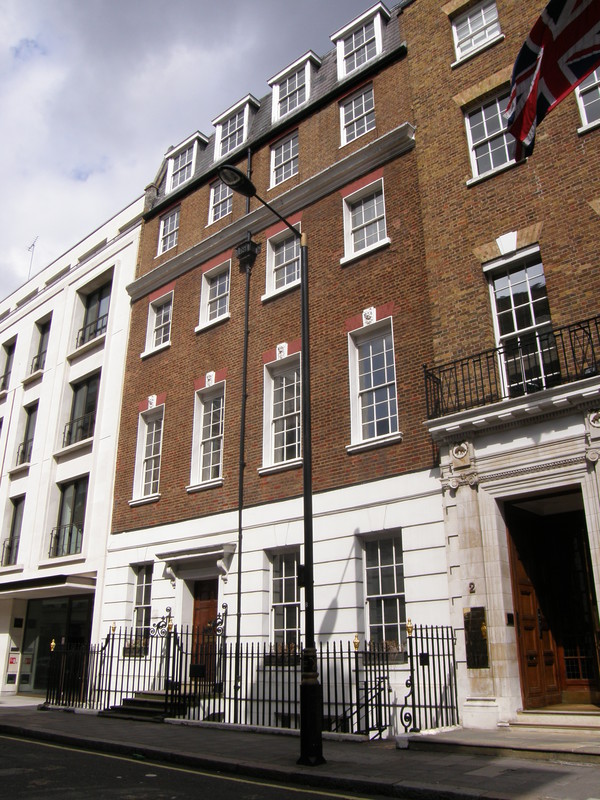
The theme for this area of London is shopping, and shopping with style. Albemarle Street is known for its art galleries, and the Royal Arcade, which dates from 1879, joins Albemarle Street to Old Bond Street, tempting you with silver shops, art galleries, shoemakers and chocolatiers under a tastefully garish orange and white stucco roof. Out on Old Bond Street is the famous jeweller Tiffany & Co., and a little way along Burlington Gardens is the Burlington Arcade, an even older and larger arcade that was opened in 1819 and is still patrolled by the Burlington Arcade Beadles, who wear traditional uniforms, including top hats and tails. Next up is Savile Row, which is famous for suits and – I now know – judicial robes and wigs, and the shopping paradise of Regent Street is only a block away, though there are more important things in life than shopping, so we stuck to the backstreets instead.
One of those more important things happened at the southern end of Savile Row, because number three was where the Beatles set up the headquarters of Apple Corps, the media company they created back in 1968. These days it's a fairly unpretentious Georgian terrace, but it was on the roof, back on , that the Beatles made their last ever live performance; the results can be seen in the film Let It Be, and one can only assume the cameras saw more than the punters below, as the roof is all but invisible from the stalls.
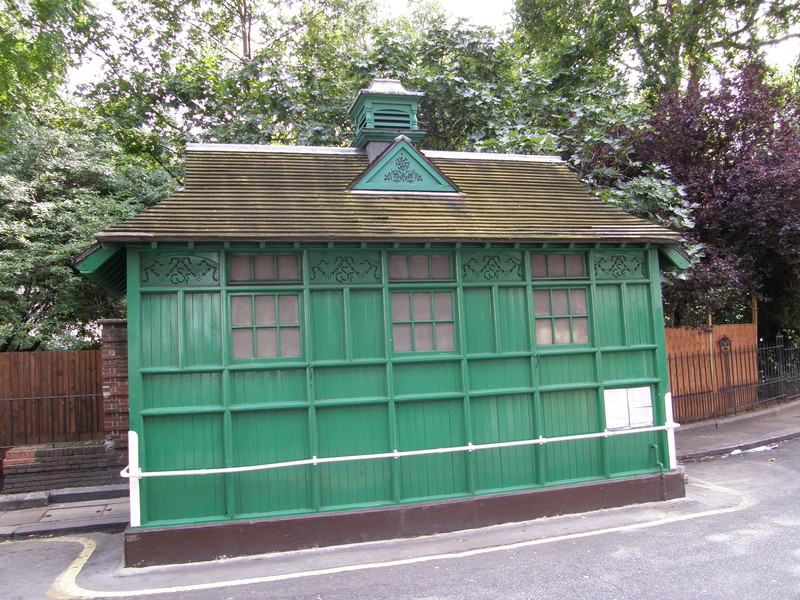
Heading north, there are fewer shops as you approach Maddox Street and turn into Hanover Square, which has a pretty little garden in the middle that's open to the public. Most of the square is home to exclusive offices, such as the London office of Vogue publisher Condé Nast Publications, which makes the little cabbie stop in the north of the square even more cherished. There are just 13 of these green shelters in the capital, all that remains of the 61 shelters that were built between 1875 and 1914 after the Earl of Shaftesbury set up the Cabman's Shelter Fund to provide cabbies with somewhere to park and get a hot meal while at work. The shelters are no bigger than a horse and cart, as they are all on public roads and the authorities didn't want them taking up too much space, but despite their diminutive size, they pack an historic punch – back in 2004, Prince Charles stopped off at this very shelter to share a cuppa with nine other taxi drivers, as a way of saying thanks for all their hard work, which was a nice gesture.
Oxford Circus station is northeast of Hanover Square, and it was just as busy as the last two visits I made on my Central and Bakerloo walks. This was my last visit here, and I shan't miss trying to battle through the crowds on the dreaded southeast corner, where half the planet exits the station and simply stands there, wondering where to go next...
Oxford Circus to Warren Street
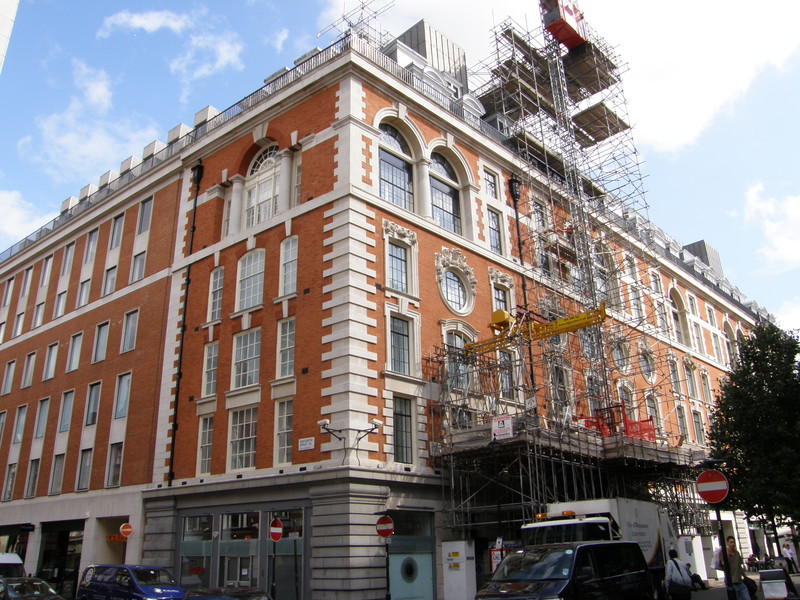
It's less commercial on the way to Warren Street, and the peace as you leave Oxford Street and duck into Great Portland Street is a considerable relief. Most shoppers seem unwilling to leave the comfort of the crowds on the main road, but they're missing out, for tucked away between Great Portland Street and Great Titchfield Street is Oxford Market, a relatively quiet square with lots of good restaurants and outside seating. Indeed, things get even quieter as you head north along Great Titchfield Street, past amazing Regency mansions made from red brick and Portland stone, all the way to Riding House Street. Look left at this point and you should be able to see All Souls' Church on Langham Place, which is opposite BBC Broadcasting House, a spot I visited back on my Bakerloo walk.

More interesting buildings line Ogle Street and New Cavendish Street, where huge Roman Catholic churches rub shoulders with the modern buildings of the University of Westminster, but for me, the excitement of catching your first glance of the BT Tower puts everything else in the shade. It's a close call between the BT Tower and the Gherkin for the top slot in my list of favourite London buildings, but I think the BT Tower probably wins out, because I've loved it all my life. I really don't know why: it's such a dated 1960s design and you haven't been able to go up it since 1981, well before I started travelling independently (though the closure isn't because of the bomb that the Provisional IRA set off in the men's toilets at the top, as that was back in 1971). But there's something about its symmetry and simple structure that appeals to me on a primitive level, and I've never lost that sense of wonder. I highly recommend you walk along Cleveland Mews, just to the east of the tower, as you can then see the whole thing in one go, and can appreciate the way that the tower is constructed, bolted onto a central concrete core that's surprisingly small. It was designed not to move more than 25cm at the top in wind speeds of up to 95 mph, which is pretty impressive for a 189m-high structure, and these days it even lights up at night like a psychedelic candle. What's not to love about the BT Tower?
Just north of the tower is Fitzroy Square, which has been in a state of roadwork chaos for months now, though they've now started layering on the tarmac, so perhaps they will have finished soon... and just along Warren Street is, you guessed it, Warren Street station, out in the crowds of Tottenham Court Road. And that's where we ended for the day, as I've already walked between Warren Street and King's Cross St Pancras on my Northern line walk; I'll pick the Victoria line up from the latter tomorrow, and polish off the rest of the line to Walthamstow.